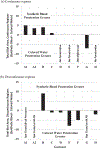Evaluation of gowns and coveralls used by medical personnel working with Ebola patients against simulated bodily fluids using an Elbow Lean Test
- PMID: 27171285
- PMCID: PMC9724155
- DOI: 10.1080/15459624.2016.1186279
Evaluation of gowns and coveralls used by medical personnel working with Ebola patients against simulated bodily fluids using an Elbow Lean Test
Abstract
Gowns and coveralls are important components of protective ensembles used during the management of known or suspected Ebola patients. In this study, an Elbow Lean Test was used to obtain a visual semi-quantitative measure of the resistance of medical protective garments to the penetration of two bodily fluid simulants. Tests were done on swatches of continuous and discontinuous regions of fabrics cut from five gowns and four coveralls at multiple elbow pressure levels (2-44 PSI). Swatches cut from the continuous regions of one gown and two coveralls did not have any strike-through. For discontinuous regions, only the same gown consistently resisted fluid strike-through. As hypothesized, with the exception of one garment, fluid strike-through increased with higher applied elbow pressure, was higher for lower fluid surface tension, and was higher for the discontinuous regions of the protective garments.
Keywords: Ebola; Elbow Lean Test; medical garment; strike-through; synthetic blood.
Figures




References
-
- American Association of Textile Chemists and Colorists (AATCC): Water resistance: impact penetration test. (AATCC 42–2000). [Technical Manual] Research Triangle Park, NC: 2000.
-
- American Association of Textile Chemists and Colorists (AATCC): Water resistance: hydrostatic pressure test. (AATCC 127–1998). [Technical Manual] Research Triangle Park, NC: 1998.
-
- American Society for Testing and Materials (ASTM): Standard Test Method for Resistance of Materials Used in Protective Clothing to Penetration by Blood-Borne Pathogens Using Phi-X174 Bacteriophage Penetration as a Test System (ASTM F1671 / F1671M – 13). [Standard] Philadelphia, PA.: ASTM, 2013.
-
- American Society for Testing and Materials (ASTM): Standard Test Method for Resistance of Materials Used in Protective Clothing to Penetration by Synthetic Blood (ASTM F1670 / F1670M – 08). [Standard] Philadelphia, PA.: ASTM, 2014.
-
- Bausch DG, Towner JS, Dowell SF, et al. : Assessment of the risk of Ebola virus transmission from bodily fluids and fomites. J. Infect. Dis 196(Suppl 2):S142–7 (2007). - PubMed
MeSH terms
Grants and funding
LinkOut - more resources
Full Text Sources
Other Literature Sources
Medical
Research Materials
